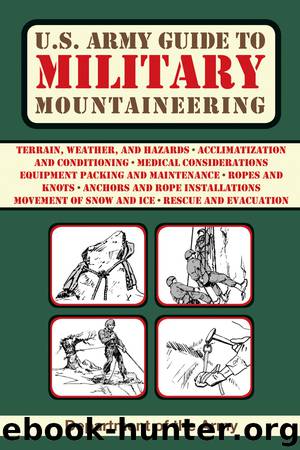U.S. Army Guide to Military Mountaineering by Department of the Army

Author:Department of the Army [Army, Department of the]
Language: eng
Format: epub, azw3
Publisher: Skyhorse Publishing (Perseus)
Published: 2013-12-31T22:00:00+00:00
Figure 6-11. Examples of jam holds.
6-10. COMBINATION TECHNIQUES
The positions and holds previously discussed are the basics and the ones most common to climbing. From these fundamentals, numerous combination techniques are possible. As the climber gains experience, he will learn more ways to position the hands, feet, and body in relation to the holds available; however, he should always strive to climb with his weight on his feet from a balanced stance.
a. Sometimes, even on an easy route, the climber may come upon a section of the rock that defies the basic principles of climbing. Short of turning back, the only alternative is to figure out some combination technique that will work. Many of these type problems require the hands and feet to work in opposition to one another. Most will place more weight on the hands and arms than is desirable, and some will put the climber in an “out of balance” position. To make the move, the climber may have to “break the rules” momentarily. This is not a problem and is done quite frequently by experienced climbers. The key to using these type of combination techniques is to plan and execute them deliberately, without lunging or groping for holds, yet quickly, before the hands, arms, or other body parts tire. Still, most of these maneuvers require good technique more than great strength, though a certain degree of hand and arm strength certainly helps.
b. Combination possibilities are endless. The following is a brief description of some of the more common techniques.
(1) Change Step. The change step, or hop step, can be used when the climber needs to change position of the feet. It is commonly used when traversing to avoid crossing the feet, which might put the climber in an awkward position. To prevent an off balance situation, two solid handholds should be used. The climber simply places his weight on his handholds while he repositions the feet. He often does this with a quick “hop,” replacing the lead foot with the trail foot on the same hold. Keeping the forearms against the rock during the maneuver takes some of the strain off the hands, while at the same time strengthening the grip on the holds.
(2) Mantling. Mantling is a technique that can be used when the distance between the holds increases and there are no immediate places to move the hands or feet. It does require a ledge (mantle) or projection in the rock that the climber can press straight down upon. (Figure 6-12, page 6-20, shows the mantling sequence.)
(a) When the ledge is above head height, mantling begins with pull holds, usually “hooking” both hands over the ledge. The climber pulls himself up until his head is above the hands, where the pull holds become push holds. He elevates himself until the arms are straight and he can lock the elbows to relax the muscles. Rotating the hands inward during the transition to push holds helps to place the palms more securely on the ledge. Once the arms are locked, a foot can be raised and placed on the ledge.
Download
U.S. Army Guide to Military Mountaineering by Department of the Army.azw3
This site does not store any files on its server. We only index and link to content provided by other sites. Please contact the content providers to delete copyright contents if any and email us, we'll remove relevant links or contents immediately.
In a Sunburned Country by Bill Bryson(3379)
Annapurna by Maurice Herzog(3307)
How to Read Nature by Tristan Gooley(3091)
Dangerous Girls by Haas Abigail(2848)
SAS Survival Handbook by John 'Lofty' Wiseman(2587)
The Lost Art of Reading Nature's Signs by Tristan Gooley(2553)
In the Woods by Tana French(2428)
The Stranger in the Woods by Michael Finkel(2334)
Food and Water in an Emergency by Food & Water In An Emergency(2274)
Guns, Germs and Steel by Diamond Jared(2206)
Wild: From Lost to Found on the Pacific Crest Trail by Cheryl Strayed(2147)
Everest the Cruel Way by Joe Tasker(2136)
Backpacker the Complete Guide to Backpacking by Backpacker Magazine(2116)
Trail Magic by Trevelyan Quest Edwards & Hazel Edwards(2065)
Ultimate Navigation Manual by Lyle Brotherton(2058)
Sea Survival Handbook by Keith Colwell(2050)
Welcome to the Goddamn Ice Cube by Blair Braverman(1889)
Birds of the Pacific Northwest by Shewey John; Blount Tim;(1879)
The Last Flight by Julie Clark(1848)
